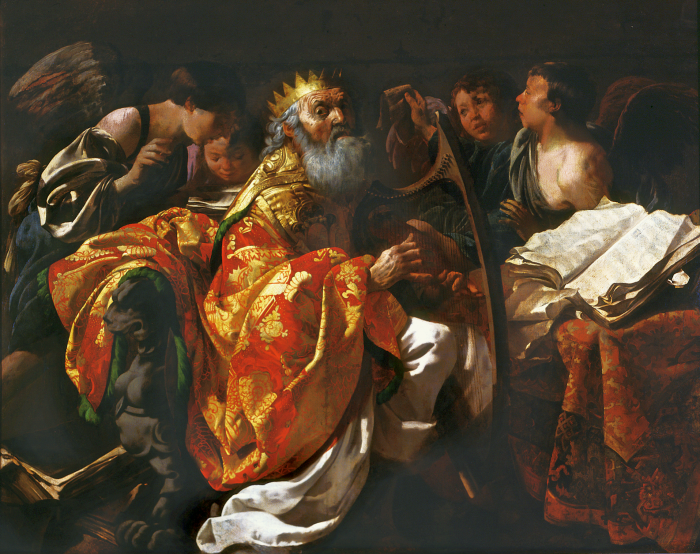
Lesson Objectives
- To understand the symbolism Matthew uses to convey the truth that Jesus Christ is the perfect Son of David.
- To see how the baptism of Jesus corresponds to the anointing of the Davidic kings.
- To understand how Matthew sees Jesus’ kingdom as the fulfillment of the promises in the prophets.
II. The Lord’s Anointed
A. The Baptism of Jesus
John the Baptist was a popular and successful preacher who lived in the wilderness and called the people to repentance. As a sign of their repentance, he baptized them - that is, gave them a ceremonial washing - in the river Jordan.
All kinds of people came in crowds to be baptized by John. But one of those people was a surprise to John. It was John’s own cousin Jesus.
“Then Jesus came from Galilee to John at the Jordan to be baptized by him. John tried to prevent him, saying, ‘I need to be baptized by you, and yet you are coming to me?’ Jesus said to him in reply, ‘Allow it now, for thus it is fitting for us to fulfill all righteousness.’ Then he allowed him” (see Matthew 3:13-15.)
Jesus’ response is a little hard to understand. What did He mean when He said, “it is fitting for us to fulfill all righteousness”?
Even though Jesus had no sin himself, it was necessary for Him to be identified with sinners.
But John the Baptist was a Levite and a prophet, and his baptizing Jesus had another ceremonial significance.
B. Anointing the Christ
All the kings of the house of David were anointed by Levite priests, and often those priests were known as prophets as well. David himself was anointed by Samuel (see 1 Samuel 16:13), a Levite priest and one of the most illustrious prophets of the Old Testament. Saul, who was king before David, had also been anointed by Samuel.
The anointing was done by pouring oil on the head of the anointed one. The effect that followed the anointing was the coming of the Spirit of the Lord:
“The spirit of the LORD will rush upon you” (see 1 Samuel 10:6); “the spirit of the LORD rushed upon David” (see 1 Samuel 16:13).
When the king had been anointed that way, he was known as the Lord’s Anointed One.
Even Saul, wicked though he was in his later years, was still the Lord’s Anointed in David’s eyes. In spite of years of civil war between Saul and David, when David had a chance to kill Saul, he refused.
“He said to his men, ‘The LORD forbid that I should do such a thing to my master, the LORD’S anointed, as to lay a hand on him, for he is the Lord’s anointed’ “(see 1 Samuel 24:7).
The Hebrew word for “Anointed One” is “Messiah.” The Greek translation is “Christ.”
In other words, every king in David’s line was the Christ, the Anointed One.
C. Son of God
David and all the kings of his line were given an extraordinary promise by God: “I will be a Father to him and he shall be a son to Me” (see 2 Samuel 7:14).
As we saw in the first lesson in this series, this is the first time in Scripture that the idea of divine sonship is applied to one individual. While God had referred to Israel as His first-born son, no one as yet in the Bible has been called, in effect, a “son of God.”
Psalm 2 puts the promise in poetic form:
“I will proclaim the decree of the LORD, who said to me, ‘You are my son; today I am your father. Only ask it of me, and I will make your inheritance the nations, your possession the ends of the earth’ “(see Psalm 2:7).
Not only is the Lord’s Anointed, promised that he will be Son of God, but he also has all nations to “the ends of the earth” for his inheritance.
D. Jesus Anointed in the Jordan
Matthew has already shown us that Jesus was the perfect Son of David, the heir to the kingdom of David.
David and the kings that followed him were anointed by Levites. Jesus was baptized in the Jordan by a Levite.
When an Old Testament king was anointed, “the spirit of the LORD rushed upon” that king (see 1 Samuel 16:13).
“After Jesus was baptized, he came up from the water and behold, the heavens were opened (for him), and he saw the Spirit of God descending like a dove (and) coming upon him (see Matthew 3:16).
David and the kings of his line were also were adopted as sons of God: God promised them that He would be their father.
When Jesus was baptized, a voice from heaven made the same proclamation about Him: “And a voice came from the heavens, saying, ‘This is my beloved Son, with whom I am well pleased’ “(see Matthew 3:17).
All the familiar images of the Davidic king from the Old Testament come back at once in the story of Jesus’ baptism. Matthew shows us that Jesus is not simply being washed in the river: He is being anointed by a Levite prophet.
Jesus is the Lord’s Anointed, the Son of God - the titles that by God’s unalterable promise belong to the Son of David who reigns as King of Israel.
Lesson Outline
Other Lessons
- Lesson One: A Throne Established Forever
- To begin to appreciate the significance of God’s covenant with David for understanding the content and meaning of the New Testament.
- To understand the biblical idea of the monarchy and the Old Testament background for the Davidic covenant.
- To understand the basic outlines of the promises made to David and the shape of the Davidic kingdom under both David and Solomon.
- Lesson Two: Looking for the ‘New David’
- To understand the basic outline of Israel’s history in the centuries between the collapse of the Davidic kingdom and the beginning of the New Testament era.
- To appreciate how the collapse and disappearance of the Davidic Kingdom shaped Israel’s hopes and beliefs in the five centuries before Christ.
- To understand how God’s covenant promises were interpreted by Israel’s prophets and how those prophecies were understood in the last centuries before Christ.
- Lesson Four: The Throne of David, His Father
- To see how Luke emphasizes Jesus’ lineage as Son of David in the infancy narrative.
- To see how Jesus appears in public as the Son of David throughout Luke’s Gospel.
- To understand how, at the climax of Luke’s Gospel, Jesus takes his place as heir to the kingdom of David.
- Lesson Five: The Spread of the Kingdom in Acts
- To understand how Jesus’ parting words to His disciples form a map of the ideal Davidic kingdom.
- To see how the structure of the Acts of the Apostles follows that map.
- To see how Luke paints the nascent Church as the Davidic kingdom perfectly restored.
- Lesson Six: ‘The Key of David’: Church and Kingdom in the New Testament
- To understand the characteristics and identity of the kingdom of God as it is portrayed in the New Testament epistles and the Book of Revelation.
- To see how the Church is identified with the kingdom in the New Testament.
- To understand how the Church, as it is portrayed in the New Testament, bears the characteristics of the Davidic kingdom.

